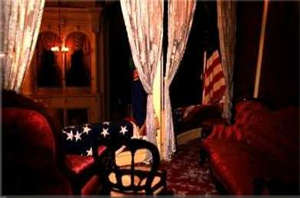Structure Report
More on Booth
The Derringer
The Chair
Lincoln Security
Petersen House
Booth's Escape
Booth Life
Chronology
Second Inaugural
Gettysburg Address
Photo Gallery
Education Program
General Info
Word Search
Good Books
Interning
Questions
Bookshop
Area Map
(Large Download, 407K
Requires plug-in,
Adobe Acrobat )

 John
Wilkes Booth, a popular actor, ended his full-time stage career in May
of 1864. The Maryland native wanted to spend most of his time on his primary
interest--supporting the Confederate States of America. Within months,
Booth was working actively with Confederate partisans. A Plan to capture
President Lincoln and exchange him for Confederate prisoners of war brought
Booth into contact with Dr. Samuel Mudd, John Surratt, his mother Mary,
Lewis Thorton Powell, David Herold, George Atzerodt, and others. This
plan failed when on the day chosen for the capture, President Lincoln
changed his plans and did not travel on the road where conspirators were
waiting.
John
Wilkes Booth, a popular actor, ended his full-time stage career in May
of 1864. The Maryland native wanted to spend most of his time on his primary
interest--supporting the Confederate States of America. Within months,
Booth was working actively with Confederate partisans. A Plan to capture
President Lincoln and exchange him for Confederate prisoners of war brought
Booth into contact with Dr. Samuel Mudd, John Surratt, his mother Mary,
Lewis Thorton Powell, David Herold, George Atzerodt, and others. This
plan failed when on the day chosen for the capture, President Lincoln
changed his plans and did not travel on the road where conspirators were
waiting.
This March 17, 1865 failure was quickly followed by two major Confederate
defeats. Richmond, the capital of the Confederacy, was abandoned to Union
troops and on Palm Sunday, April 9th, Robert E. Lee surrendered his army
to General Grant.
Soon after these defeats, Booth decided to assassinate President Lincoln while Powell was to kill Secretary of State Seward, and Atzerodt was to kill Vice President Andrew Johnson. Booth hoped to throw the country into political chaos.

Within hours of Lincoln's shooting, Booth fled Washington on horseback
and met Herold on the road. Both men rode into southern Maryland. The
pain from the broken small bone in his left leg (broken in the escape
from the State Box at Ford's Theatre) led Booth and Herold to stop at
Dr. Mudd's home for medical aid.
On April 26th, twelve days after having killed the President, Booth and Herold were surrounded while hiding in a tobacco shed in Port Royal, Virginia. Herold surrendered to the Union troops, but Booth held out and was shot while the shed burned down around him.
The other conspirators were soon arrested. Atzerodt, Herold, Powell, and Mrs. Surratt were all found guilty and sentenced to death by hanging. Dr. Mudd and two others involved in the original capture attempt were sentenced to life in prison. Edman Spangler, who held Booth's horse during the assassination, was sentenced to six years hard labor. In 1869, President Andrew Johnson pardoned the surviving conspirators.

NACC_FOTH_Interpretation@nps.gov
Updated: Monday, 08-Oct-01 11:46:05
